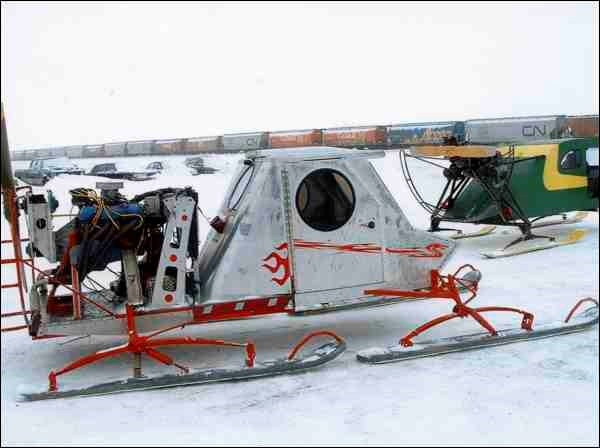The first snow plane rally of 2013 was held Jan. 27 at Davidson. Charlie Deaver had invited the snow plane owners to come. They had a turnout of seven snow planes board from various areas of Saskatchewan. It turned out to be a lovely day, not too mild, and the snow was packed deep and crisp. It was a perfect day to have fun and that is what they did.
Many interested people went for rides or watched the snow planes run.
Snow planes have been around for a long time. When they were first built in 1928, the winters were long and hard with deep snow and sub zero temperatures for long lengths of time. Travel in the country was mainly by driving horses and sleighs and cutters. A young fellow at Spy Hill along with his father, George Lorch, ran a car dealership. He constructed the first snow plane from the body of a Model T car. He was always interested in airplanes and visited the airports often. It was during one of these visits he watched a plane equipped with skis land and take off. He thought it would be possible for a machine with skis and a motor with attached propeller mounted at the rear to push the machine along the ground in the same way as the front mounted motor and propeller pulled the planes.
Snow planes were built from light aircraft materials to make them lighter and easier for the motor and fan on the back to move. Most held two or four passengers. Some were built with three skis, one on the front and two on the rear. Later four skis were more common.
Home built plans shared similar designs. The old ones were covered with a strong aircraft linen materials. Then the covering was dipped with a strong foul smelling liquid banana oil applied with a brush. This application tightened the linen and removed the wrinkles. The surface was then ready to paint.
The snow planes made today are made of aluminum and light metal for the frame. Lorch snow planes were designed to speed up winter transportation for mail carriers, police, doctors, livery men, commercial travellers and the mechanical minded farmer. They did frighten horses and were noisy. Horses were used by most winter travellers at that time.
Various types of motors were installed on the rear of the snow plane. The large propellers were enclosed in a special cage to prevent contact with the fast moving fins.
Snow planes were a work horse in their day and special vehicles for winter emergencies. They were used in the deep snow and snow banks and likely a blizzard or two. Running out of fuel or breaking a propeller were among the hazards of snow plane travel.
After a 20-year span of active use, snow planes passed into history in the 1950s when better vehicles were on the roads. Today the snow planes are all being home built and used for recreational purposes. Some of the interested older men are building their own snow planes to go to the rallies that are set up in various areas in the winter months. They all need a good snow cover to run the skis or else they do not operate too well. At one time, the snow planes were so popular, there were two companies building in Saskatchewan and they built many. They are mostly gone now but there are a few left.
A second snow plane rally was held at Preeceville Feb. 3. There were five snow planes out, many more interested people showed up for rides. The weather played the game for the day and the snow conditions were favourable.
Another rally is set for Howarden Feb. 23. Depending on the weather there may be one or two more rallies in March. No dates are set yet.



